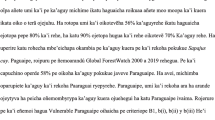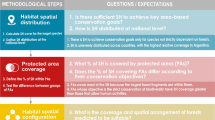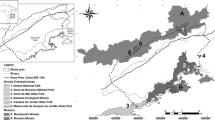Abstract
Species distribution data provide critical baseline information for conservation planning and decision making. However, in many of the Earth’s most biodiverse regions, such data are lacking for many species. Here, we used ecological niche modeling and connectivity analyses to model distributions of endangered species and protected area connectivity across the Upper Guinea Forest (UGF) Global Conservation Hotspot of West Africa. We estimated the current distributions of African forest elephant Loxodonta cyclotis (Vulnerable), western chimpanzee Pan troglodytes verus (Critically Endangered), and pygmy hippopotamus Choeropsis liberiensis (Endangered) across the region and optimized connectivity in two main forest complexes in the region. We used occurrence data for the period 2010–2016 for the three species from two well-sampled national parks in Liberia (Sapo National Park and Gola National Park), and remotely sensed MODIS enhanced vegetation index data for the period 2010–2015. Our models predicted a total of 75,157 km2 of suitable habitat for chimpanzees in the region, 79,400 km2 for elephants, and 290,696 km2 for hippos. Of these areas, for chimpanzees, 30% of the area predicted falls within the boundaries of proposed or designated protected areas, and likewise 30% for elephants, and 19% for hippos. Liberia had the largest blocks of contiguous forest suitable for these species compared to other countries in the region but this forest was largely unprotected. This study identifies priority areas for biodiversity conservation and forest connectivity in the region, and reemphasizes the practicality of these tools to optimize conservation planning and implementation.




Similar content being viewed by others
References
Abdi H, Williams LJ (2010) Principal component analysis. Wiley Interdiscip Rev Comput Stat 2:433–459
Allport G (1991) The status and conservation of threatened birds in the Upper Guinea forest. Bird Conserv Int 1:53–74
Ball IR, Possingham HP, Watts M (2009) Marxan and relatives: software for spatial conservation prioritisation. In: Spatial conservation prioritisation: quantitative methods and computational tools, pp 185–195
Barve N, Barve V, Jiménez-Valverde A et al (2011) The crucial role of the accessible area in ecological niche modeling and species distribution modeling. Ecol Model 222:1810–1819
Beier P, Spencer W, Baldwin RF, McRAE BH (2011) Toward best practices for developing regional connectivity maps: regional connectivity maps. Conserv Biol 25:879–892
Bodbyl-Roels S, Peterson AT, Xiao X (2011) Comparative analysis of remotely-sensed data products via ecological niche modeling of avian influenza case occurrences in Middle Eastern poultry. Int J Health Geogr 10:1–21
Bottrill MC, Joseph LN, Carwardine J et al (2008) Is conservation triage just smart decision making? Trends Ecol Evol 23:649–654
Bottrill MC, Joseph LN, Carwardine J et al (2009) Finite conservation funds mean triage is unavoidable. Trends Ecol Evol 24:183–184
Brás R, Cerdeira JO, Alagador D, Araújo MB (2013) Linking habitats for multiple species. Environ Model Softw 40:336–339
Brown JL (2014) SDMtoolbox: a python-based GIS toolkit for landscape genetic, biogeographic and species distribution model analyses. Methods Ecol Evol 5:694–700
Carignan V, Villard M-A (2002) Selecting indicator species to monitor ecological integrity: a review. Environ Monit Assess 78:45–61
Cushman SA, Elliot NB, Bauer D et al (2018) Prioritizing core areas, corridors and conflict hotspots for lion conservation in southern Africa. PLoS ONE 13:e0196213
Darwall W, Polidoro B, Smith K, Somda J (2015) Ecosystem profile Guinean Forests of West Africa biodiversity hotspot. Critical Ecosystem Partnership Fund Report
DeMatteo KE, Rinas MA, Zurano JP et al (2017) Using niche-modelling and species-specific cost analyses to determine a multispecies corridor in a fragmented landscape. PLoS ONE 12:e0183648
Dickson BG, Roemer GW, McRae BH, Rundall JM (2013) Models of regional habitat quality and connectivity for pumas (Puma concolor) in the southwestern United States. PLoS ONE 8:e81898
Feilhauer H, He KS, Rocchini D (2012) Modeling species distribution using niche-based proxies derived from composite bioclimatic variables and MODIS NDVI. Remote Sens 4:2057–2075
Fourcade Y, Engler JO, Rödder D, Secondi J (2014) Mapping species distributions with MAXENT using a geographically biased sample of presence data: a performance assessment of methods for correcting samplingbias. PLoS ONE 9:e97122
Franklin JF (1993) Preserving biodiversity: species, ecosystems, or landscapes? Ecol Appl 3:202–205
Freeman B, Danjuma DF, Molokwu-Odozi M (2018) Status of globally threatened birds of Sapo National Park. Ostrich-J Afr Ornithol, Liberia. https://doi.org/10.2989/00306525.2018.1502694
Hearn AJ, Cushman SA, Goossens B et al (2018) Evaluating scenarios of landscape change for Sunda clouded leopard connectivity in a human dominated landscape. Biol Conserv 222:232–240
Iloh AC, Ogundipe O (2016) Using ecological niche modelsto plan conservation in a changing environment: a case for the plant Chasmanthera dependens Hochst (Menispermaceae) in West Africa. J Ecol Nat Environ 8:1–8
Jennings AP, Veron G (2015) Predicted distributions, niche comparisons, and conservation status of the spotted linsang and banded linsang. Mammal Res 60:107–116
Junker J, Boesch C, Freeman T et al (2015) Integrating wildlife conservation with conflicting economic land-use goals in a West African biodiversity hotspot. Basic Appl Ecol 16:690–702
Khosravi R, Hemami M-R, Cushman SA (2018) Multispecies assessment of core areas and connectivity of desert carnivores in central Iran. Divers Distrib 24:193–207
Lehtomäki J, Moilanen A (2013) Methods and workflow for spatial conservation prioritization using Zonation. Environ Model Softw 47:128–137
Lindenmayer DB, Fischer J, Felton A et al (2007) The complementarity of single-species and ecosystem-oriented research in conservation research. Oikos 116:1220–1226
Liu Z, Wimberly MC, Dwomoh FK (2016) Vegetation dynamics in the Upper Guinean Forest Region of West Africa from 2001 to 2015. Remote Sens 9:1–5
McRae BH, Dickson BG, Keitt TH, Shah VB (2008) Using circuit theory to model connectivity in ecology, evolution, and conservation. Ecology 89:2712–2724
McRae B, Shah V, Edelman A (2016) Circuitscape: modeling landscape connectivity to promote conservation and human health. Nat Conserv
Muscarella R, Galante PJ, Soley-Guardia M et al (2014) ENMeval: an R package for conducting spatially independent evaluations and estimating optimal model complexity for Maxent ecological niche models. Methods Ecol Evol 5:1198–1205
NFRL (2006) National Forestry Reform Law of 2006. http://www.fao.org/forestry/16151-05fd47b845599b5d3a594a9b0240dacff.pdf. Accessed 1 May 2018
Owens HL, Campbell LP, Dornak LL et al (2013) Constraints on interpretation of ecological niche models by limited environmental ranges on calibration areas. Ecol Model 263:10–18
Peterson AT (2014) Mapping disease transmission risk: enriching models using biogeography and ecology. Johns Hopkins University Press, Baltimore
Peterson AT, Papeş M, Soberón J (2008) Rethinking receiver operating characteristic analysis applications in ecological niche modeling. Ecol Model 213:63–72
Peterson AT, Soberón J, Pearson RG et al (2011) Ecological niches and geographic distributions. Princeton University Press, Princeton
Peterson AT, Campbell LP, Moo-Llanes DA et al (2017) Influences of climate change on the potential distribution of Lutzomyia longipalpis sensu lato (Psychodidae: Phlebotominae). Int J Parasitol 10–11:667–674
Phillips SJ, Dudík M (2008) Modeling of species distributions with Maxent: new extensions and a comprehensive evaluation. Ecography 31:161–175
Phillips SJ, Dudík M, Schapire RE (2006) A maximum entropy approach to species distribution modeling. In: Proceedings of the twenty-first international conference on Machine learning. ACM, p 83
Pimm SL, Jenkins CN, Abell R et al (2014) The biodiversity of species and their rates of extinction, distribution, and protection. Science 344:1246752
Primack RB (2010) Essentials of conservation biology. Sinauer Associates, Sunderland
Roever CL, van Aarde RJ, Leggett K (2013) Functional connectivity within conservation networks: delineating corridors for African elephants. Biol Conserv 157:128–135
Saupe EE, Barve V, Myers CE et al (2012) Variation in niche and distribution model performance: the need for a priori assessment of key causal factors. Ecol Model 237–238:11–22
Shcheglovitova M, Anderson RP (2013) Estimating optimal complexity for ecological niche models: a jackknife approach for species with small sample sizes. Ecol Model 269:9–17
Squires D (2014) Biodiversity conservation in Asia. Asia Pac Policy Stud 1:144–159
Thomas CD, Cameron A, Green RE et al (2004) Extinction risk from climate change. Nature 427:145–148
Tweh CG, Lormie MM, Kouakou CY et al (2015) Conservation status of chimpanzees Pan troglodytes verus and other large mammals in Liberia: a nationwide survey. Oryx 49:710–718
UNESCO World Heritage (2018) Western Area Peninsula National Park. In: UNESCO World Herit. Cent. https://whc.unesco.org/en/tentativelists/5741/. Accessed 18 Apr 2018
Vogt M (2012) Biomonitoring & research programme, Sapo National Park: updated plan for research opportunities and priorities in and around Sapo National Park. Fauna Flora Int Liberia
Warren DL, Glor RE, Turelli M (2010) ENMTools: a toolbox for comparative studies of environmental niche models. Ecography 33:607–611
Warren DL, Wright AN, Seifert SN et al (2013) Incorporating model complexity and spatial sampling bias into ecological niche models of climate change risks faced by 90 California vertebrate species of concern. Divers Distrib 20:334–343
Wilkie DS, Bennett EL, Peres CA, Cunningham AA (2011) The empty forest revisited. Ann N Y Acad Sci 1223(1):120–128
Wilson KA, Underwood EC, Morrison SA et al (2007) Conserving biodiversity efficiently: what to do, where, and when. PLoS Biol 5:e223
Wold S, Esbensen K, Geladi P (1987) Principal component analysis. Chemom Intell Lab Syst 2:37–52
Zacarias D, Loyola R (2018) Distribution modelling and multi-scale landscape connectivity highlight important areas for the conservation of savannah elephants. Biol Conserv 224:1–8. https://doi.org/10.1016/j.biocon.2018.05.014
Acknowledgements
This study was made possible by the contribution of data from Fauna & Flora International, Liberia (FFI) for Sapo NP; the Society for Conservation of Nature in Liberia (SCNL), Conservation Society of Sierra Leone (CSSL), and the Royal Society for the Protection of Birds (RSPB) for Gola forest in Liberia and Sierra Leone; and Wild Chimpanzee Foundation and the Pan African Programme at the Max-Planck Institute for other parts of the region. We are also very grateful to developers of the APES database (http://apesportal.eva.mpg.de/database) for providing access to these datasets. Finally, we are thankful to the participants of KU-EEB’s spring semester (2018) scientific writing working group class for critical reviews of previous drafts of this manuscript, Daniel Jiménez-Garcia and Lindsay Campbell for their advice on processing remote sensing data, and Luis Osorio for writing the R script used in the MOP analysis.
Author information
Authors and Affiliations
Corresponding author
Additional information
Communicated by Samuel Cushman.
This article belongs to the Topical Collection: Forest and plantation biodiversity.
Rights and permissions
About this article
Cite this article
Freeman, B., Roehrdanz, P.R. & Peterson, A.T. Modeling endangered mammal species distributions and forest connectivity across the humid Upper Guinea lowland rainforest of West Africa. Biodivers Conserv 28, 671–685 (2019). https://doi.org/10.1007/s10531-018-01684-6
Received:
Revised:
Accepted:
Published:
Issue Date:
DOI: https://doi.org/10.1007/s10531-018-01684-6




